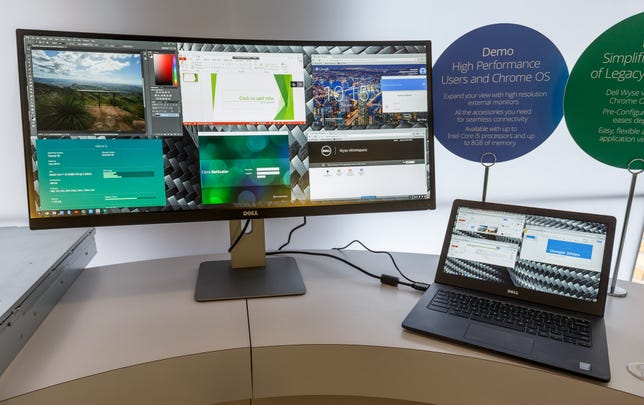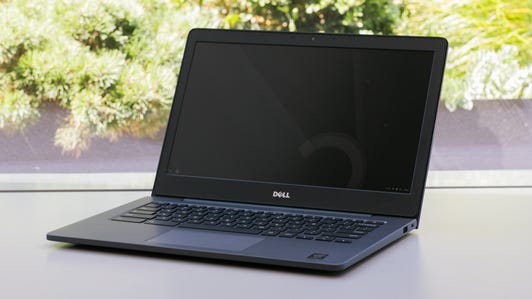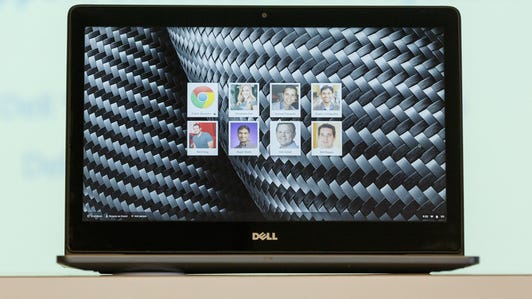
Stephen Shankland/CNET
MOUNTAIN VIEW, Calif. — Google’s high-end, high-priced Chromebook Pixel laptop became a market success in its creators’ eyes on Thursday — by influencing the design of a more affordable competitor from Dell.
The $1,299 Chromebook Pixel from 2013 and $999 Chromebook Pixel 2 introduced this year both run Chrome OS, Google’s browser-based operating system designed to challenge Microsoft’s Windows and Apple’s OS X. Chromebooks have had limited appeal, in part because they run Web-based apps like Google Docs and Facebook but not traditional PC software like Microsoft Office and Adobe Photoshop, and the Pixel models’ high prices cut that appeal even further.
But the Pixels succeeded in their mission to influence more mainstream Chromebooks, said Rajen Sheth, leader of Google’s work to push Chrome OS in businesses and schools, in an interview here at Google headquarters.
“In the early days of Chromebooks, most were low-priced plasticky devices. There’s charm to that, but there are also premium users who want to have a better device,” Sheth said. “The Pixel is the best Chromebook out there. This Dell is going to be easily the second best and at a much more affordable price.”
The Dell Chromebook 13 starts at $399 for a laptop with a metal exterior, carbon fiber cover, 13-inch 1,920×1,080 screen, Intel Celeron processor, 2 gigabytes of memory and 16GB of storage. Prices range up to $899 for models with touch screens and more powerful brains. For full details, check out my colleague Dan Ackerman’s look at the Dell Chromebook 13.
Dell Chromebook 13






Chromebooks embody Google’s seemingly boundless ambition. The OS X and Linux operating systems have barely dented the dominance of Microsoft’s Windows on PCs, but Google thinks Chrome OS can. Success will mean more options for consumers and laptops that are accessible to low-budget buyers like schools and people in poorer nations.
Chromebooks are a success in schools, but their reliance on a network connection and inability to run a lot of Windows programs means they’re not a mainstream product, said Gartner analyst Mikako Kitagawa. Still, they accounted for 8.1 percent of portable computer shipments in the first quarter of 2015 in the United States, she said. That figure should rise to 10.6 percent for the full year and rise further to 12.4 percent for 2016, she added.
Strong in schools
Schools like Chromebooks for a couple of reasons. “First, the hardware is extremely cheap. Second, the teachers can control what they provide to the kids and restrict what kids can access,” she said. “It’s perfect for K-12,” when students are between about 5 and 18 years old.
Sheth attributes Chromebooks’ educational success to their low cost — including low management costs. They’re centrally managed so teachers don’t waste time handling tech support, he said.
In addition, the devices are easily shared, with students’ data and settings stored in the cloud and retrieved when they log in. And Google Apps for Education, free to schools and now with more than 45 million students using it daily, offers low-cost software for word processing, email, file sharing, presentations and chatting. It’s working well enough that Google says it’s pushing aside Apple’s iPad, Sheth said.


Stephen Shankland / CNET
“Previously, iPads used to dominate education in the US. Now Chromebooks are far and away the leading device in the US,” Sheth said.
Business push
Now, Google hopes to push Chrome OS more into businesses, too. The low purchasing and management costs are a big part of the sales pitch there, too.
“There are 4 billion working adults in the world, but only about 750 million PCs,” Sheth said. “With the Chromebook, companies are able to expand the population of users who have access to those devices.”
Retailer Woolworth’s is on board, with mainstream Chromebooks for employees and Pixels for executives. And now Starbucks is signing up, with Chromebooks available for employees to use for things like shift scheduling and human resources. Netflix, too, is using Chromebooks in stores.
Chrome OS devices are about half the cost to buy and operate compared to traditional PCs, said Manesh Patel, chief information officer of electronics manufacturer Sanmina, at a Chromebook 13 launch event in San Francisco. Sanmina uses Chromebooks in its factory floor, but now is expanding to the “knowledge workers” that are a core market for Microsoft Windows and Office today.
“We see over the next two years growing from 200 to 300 Chrome OS devices today to 10 to 15 times that,” Patel said. The company has 23,000 employees total, so that would be roughly a tenth of the workforce.
Business users will appreciate the Dell Chromebook 13’s build quality, Sheth said. “We believe Chromebooks are now ready for work,” he said.
Gartner’s Kitagawa doesn’t see businesses as such a good market — at least in developed countries where customers are already familiar with Windows and rely on a host of Windows programs.
Google recognizes software compatibility is a sticking point for Chrome OS in business, but it’s working on fixes, including server software from Citrix that lets companies run the software on central servers but let users tap into them with Chromebooks over the network. At its launch event, Dell demonstrated its Chromebook 13 running not just Web apps like Google Hangouts, but also Windows apps like Adobe Systems’ Photoshop and Microsoft Office.
“Making Windows apps work well on a Chromebook is key,” Sheth said.
Consumers leery
Google has long argued Chrome OS is good for consumers, too. A cheap Chromebook can be good to leave around the living room for answering email, checking Facebook, looking up recipes and helping with homework.
For now, though, consumers are staying away for the most part, Kitagawa said. Chromebooks have a high return rate because they’re affordable and look good, but customers can be surprised when they don’t work as expected: no Skype, no Windows video games, no Microsoft Office.
But she doesn’t rule them out in the long run.
“It’s going to change,” Kitagawa said. “I don’t known how long it’ll take, but in the future, everything is going to be up on your cloud. At some point a device like a Chromebook will be perfect.”




